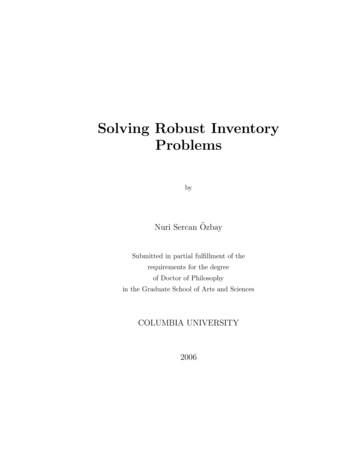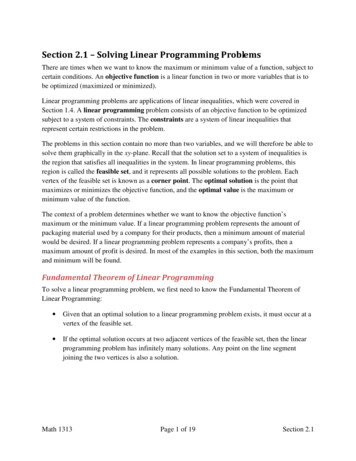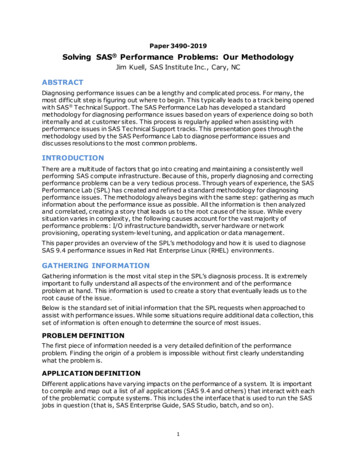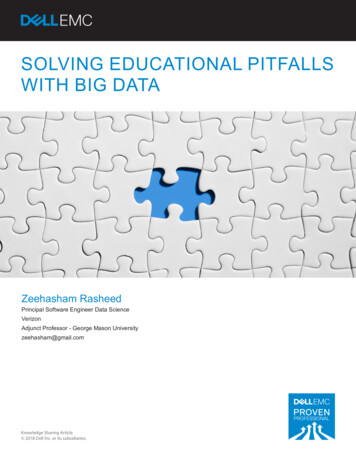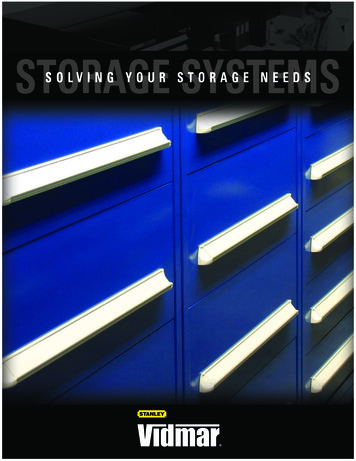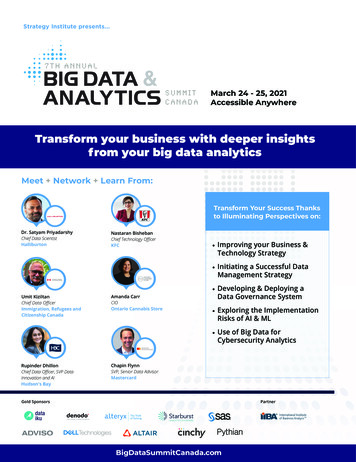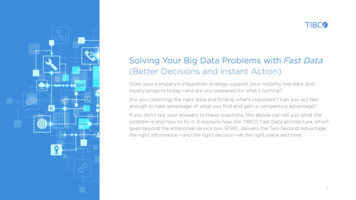
Transcription
Solving Your Big Data Problems with Fast Data(Better Decisions and Instant Action)Does your company’s integration strategy support your mobility, big data, andloyalty projects today—and are you prepared for what’s coming?Are you collecting the right data and finding what’s important? Can you act fastenough to take advantage of what you find and gain a competitive advantage?If you don’t like your answers to these questions, this ebook can tell you what theproblem is and how to fix it. It explains how the TIBCO Fast Data architecture, whichgoes beyond the enterprise service bus (ESB), delivers the Two-Second Advantage, the right information—and the right decision—at the right place and time.1
The average CIO dedicates 75 percent of their IT spend onmaintaining operations, leaving only 25 percent for morestrategic, opportunity-generating business initiatives. Asbudgets inevitably tighten, cuts always come from this 25percent. Good companies lose their competitive edge.The problem starts with IT architecture.In the 20th century, point-to-point architectures ruled.To get data from system to system, they were connected individually with specificinterfaces. It made for a complicated mess of connections. As new systems wereadded, the connections became slower and more complex.For business, point-to-point designs prevent: High speed sharing or modification Accurate visibility into business processes Fast actionFor IT, point-to-point cannot address today’s integration needs: Legacy and custom applications ERPs Cloud-hosted CRM and HR solutionsIt’s also costly to maintain.For example .2
Why maintaining point-to-point is so costly: The interface for each combination of applications is unique, can’tbe reused, and forces new development for any new interface. The combination of technologies and their required servicelevels cause latency for data integration, which impacts businessprocesses and team efficiency. The combination of technologies prevents an end-to-end view ofprocesses and hinders quality control for services. A broad set of skills is needed, increasing staff and detractingfrom strategic development. Some services that are crucial to your business are entrustedto partners, requiring processes that span organizationalboundaries, a synchronicity that will be very costly to achieve.3
YOU—business users and IT—can solve theseproblems and others by focusing on: Improving the availability of information withcontextual, event-based data Enabling fast decisions and actionsThe alternative to point-to-point is an enterpriseservices bus (ESB) that is the basis for a serviceoriented architecture (SOA). An integration platformimplemented on a bus architecture solves virtuallyany integration problem. Since each application andtechnology only requires one connection to the busto expose or consume information, the number ofinterfaces is drastically reduced.An ESB uses a publish-and-subscribe model.Information is pushed into the bus and made accessibleto the people and systems who need it—creating a oneto-many vs. one-to-one information exchange.This means less complexity, less maintenance, and moreresources for improvements that can help you compete.A bus is also the first step towards solving other bigdata problems like: Improving visibility and information accessibility Accelerating decision-making Enabling fast actionBut, while many companies use an ESB, most still don’ttake advantage of the “E,” Enterprise. They integrateapplications, but not all data, which prevents them fromgetting the full picture of what’s happening, making theright decision, and acting quickly.The ESB provides value even when it’s only integratingapplications, but unless it extends to all your data, it’snot doing everything it can do. Furthermore, it won’tsolve your big data problems because 4
An architecture that focuses on transactional data is leaving alot on the table: Historical data in data warehouses or operational data storesInsights extracted from big data at restData gathered from customers navigating the websiteData gathered from customers using a mobile application,including their location Log data generated by applications or devicesMuch of this data helps describe the context you’re operating in,which is essential.How can you understand and incorporate context into your businessoperations?Think of context as an event.In its simplest form, contextual data is a change, something new. It’s an“event.” In more sophisticated forms, it can be a specific combinationof data, or even the lack of it when something is expected. To gaindata accessibility and visibility along with the ability to make informeddecisions and take action, you need to be able to capture events andtransmit them as soon as they are available.A major improvement that big data processing offers over traditionalbusiness intelligence is the infinite array of questions that can beasked and answered. By processing more data—contextual, master,and historical—you can identify situations that you want to act on, asthey occur.How ?5
Evolve from ESB to Fast DataOur event-driven integration platformgoes beyond the ESB, taking all of theinformation flowing in it and movingit into an event server (an in-memorydata grid). The event server handlesmore than just transactional data. It letsyou include all your information. It usesinexpensive memory on servers of allsizes for a distributed architecture thatensures elasticity and low latency.Within the event server, we add analyticsthat help you identify the patterns youwant to spot, event processing to spotthose patterns (and context) in real time,and business process management toturn your insights into action.Now all of your data—millions andmillions of events and log files—can becorrelated in real time, with your businessrules driving the action.This is Fast Data.With Fast Data, you can solve businessproblems that were once unfathomable.Example: Fraud detection using Fast DataKevin is out with his family on their weekly pizza night. Beforegoing to the restaurant, he uses his ATM card at a local gasstation. Five minutes later he makes a withdrawal at the bank.These are separate events received by different servers withinhis bank being published into the event server.Three hours later in Asia, a transaction is made against hisbank account. With the old, disjointed architecture, theseevents would appear as separate and unrelated. But when youtreat them as events, correlated in real time, they indicate anattempt at fraud.With the event server using pre-existing rules, a pattern isidentified, action taken, and fraud prevented.Here’s an example .6
Data quality is crucialHow master data management (MDM) helpsEvents only provide a bit of data about a specificbusiness object, like the present location of a customer.They don’t give you enough information to engagethem. You need the ability to access and use validatedinformation about your customers, products, or otherbusiness objects at any time.MDM helps you define the data types that will beshared and used in all contexts:If you don’t achieve data validation, it will leadto unnecessary costs (such as sending multiplecommunications to the same person) and a less thanoptimal customer experience.Because it’s part of the same architecture as the eventdriven integration platform, it:The challenge is that data about business objects isscattered across applications and can change at anytime via various channels. Master data management(MDM) solves this problem and complements theevent-driven integration platform. Attributes that describe customers and otherbusiness objects Rules and processes that govern updates to theserecords Captures any change in data. Publishes an event as soon as validated data isavailable, keeping data in sync with context andensuring applications are using the right data. Exposes the right master data on demand usingthe event server to keep up with volume andvelocity.MDM is key to keeping TCO low and ensuring fastaccess to hundreds of millions of records you can trust.MDM software is like a spell checkerfor the Fast Data platform.It can make your data so accurate thatit becomes valuable to your partners orcustomers, giving you the opportunityto monetize it via an open API.7
Being event-driven is better for businessToday’s market and technological landscape generatesan increasing number of events: Mobile applications can capture events, such asuser location. Social networks provide user-generated events, aswell as millions of events about topics of interest,such as products and brands.An event-driven integration platform provides access toall data representing context, supplying the opportunityfor better, more immediate understanding of customers,opportunities, and threats. It creates the ability to makeinformed decisions on the fly.Being event-driven also improves IT systemperformanceAn event-driven approach publishes events as soon asthe change is captured. Any application interested in an event cansubscribe to it and react immediately, insteadof polling for information or waiting for a batchdelivery. The number of applications that consume thesame event does not impact the speed at whichthe event is processed, allowing the architectureto scale efficiently. Applications can easily subscribe to eventsthrough configuration without impacting theplatform. They are constantly enriched withnew data.8
Now, about big data (data at rest)Insight and action need contextBig data technologies like Hadoop and statistical engines aggregate large quantitiesof data for analysis and modeling. You can drill into metrics to understand what isdriving the results.Big data produces information based on the past, based on an aggregation ofhistoric, not present, context.And the fresher the data, the better the results. This is where event-drivenintegration works so well, by making all of your data available for processing, itimproves the quality of the results.Yet volume and variety will not solve big data’s biggest flaw. Its promise is to provideinsight. You need to develop this insight, and turn it into action.Knowing what led a customer to buy or the symptoms leading to machine failure isinteresting, but would be of far greater value if it could be applied before the fact—toencourage a purchase or avoid the need for repair.Event-driven integration builds this contextual understanding by correlating freshlyupdated business objects with master data, like this Without action, at some later point, you’ll only be able to see that you could haveprevented a problem or seized an opportunity.9
Building contextThe simple, potentially very technical event that entered thearchitecture (a server log) now has much more significance becauseit can be related to the transaction that generated it, as well as to thecustomer that initiated the transaction.That’s how the system prevented fraud on Kevin’s account.That’s how you will be able to take advantage of social and mobileinformation and cloud applications.By correlating multiple events as they occur, you can identify businessscenarios that need attention and action.The combination of event-driven integration, in-memory data grids(the event server), and a real-time analytics solution provides visibility.Now, what about decision-making and action-taking?10
Decision-making andaction-takingFirst, analyze.Start event processing.Take action.Learn.With a wide variety of events,contextual data, masterdata, historical data, and ourunparalleled streaming analytics,you can identify the situationsand patterns you want to lookfor and act on.Event processing technologycombines correlation withevent-driven rules management.It scales to ensure minimumlatency for identifying events, orthe lack of expected events, andfor triggering actions. Businessrules make the decision andtrigger the best action.Triggered by event processing,intelligent business processescan be fully automated orpartially automated withemployee involvement. Smallerlogic segments linked bydecision points make the wholeprocess more flexible.As the Fast Data platformruns, you are also analyzingthe effects of your actions. Youcan quickly adjust to get betterresults and continually improve.The system helps accelerate thislearning process and your abilityto predict and respond.And when employees needto respond—make decisionsor take action—they have fullvisibility on the context tohelp them.11
Example: The event-enabled enterprise business processBased on the context, employees interacting with customers canchange the execution path of the process, or even better, see the nextbest action.Rachel realizes she wants to buy a second item and calls customerservice. Steve answers, and instead of insisting she place anotherorder, he updates the current one, which automatically kicks offupdates to provisioning, delivery, and billing sub-processes.Updating or augmenting capabilities can be accomplished just byupdating business rules.Big DataThe volume and variety ofinformation you collect.Fast DataThe processing of big data atreal-time velocity, enablinginstant awareness and action.12
As the foundation for Fast Data, eventdriven integration future proofs yourintegration platform and lets you useyour integration budget for innovationrather than maintenance.By understanding your business contextand acting on it, you can truly make adifference: have real-time conversationswith your customers, encourage loyalty,and increase revenue.Answers to your big data problemsDoes your company’s integration strategy support your mobility, big data, and loyalty projects today—and are youprepared for what’s coming?With the ability to capture any amount of information in real time, understand context, and take action when itmatters (Fast Data), you can turn mobile, social, and loyalty, and whatever comes next into BIG advantages.Watch the TIBCO event-enabled enterprise video(04:41 min)Does the data you collect help you find what’s important? Can you act fast enough to take advantage of what youfind and gain competitive advantage?You can with TIBCO. You can leverage Fast Data to develop insight, and act in the moment to make an impact.It all starts with event-enabled, future-proof integration.Learn about ActiveMatrix BusinessWorks 6 2014, TIBCO Software Inc. All rights reserved. TIBCO, the TIBCO logo, TIBCO Software, and the Two-Second Advantage are trademarks or registered trademarks of TIBCO Software Inc. or its subsidiaries in the UnitedStates and/or other countries. All other product and company names and marks in this document are the property of their respective owners and mentioned for identification purposes only.13
It explains how the TIBCO Fast Data architecture, which goes beyond the enterprise service bus (ESB), delivers

